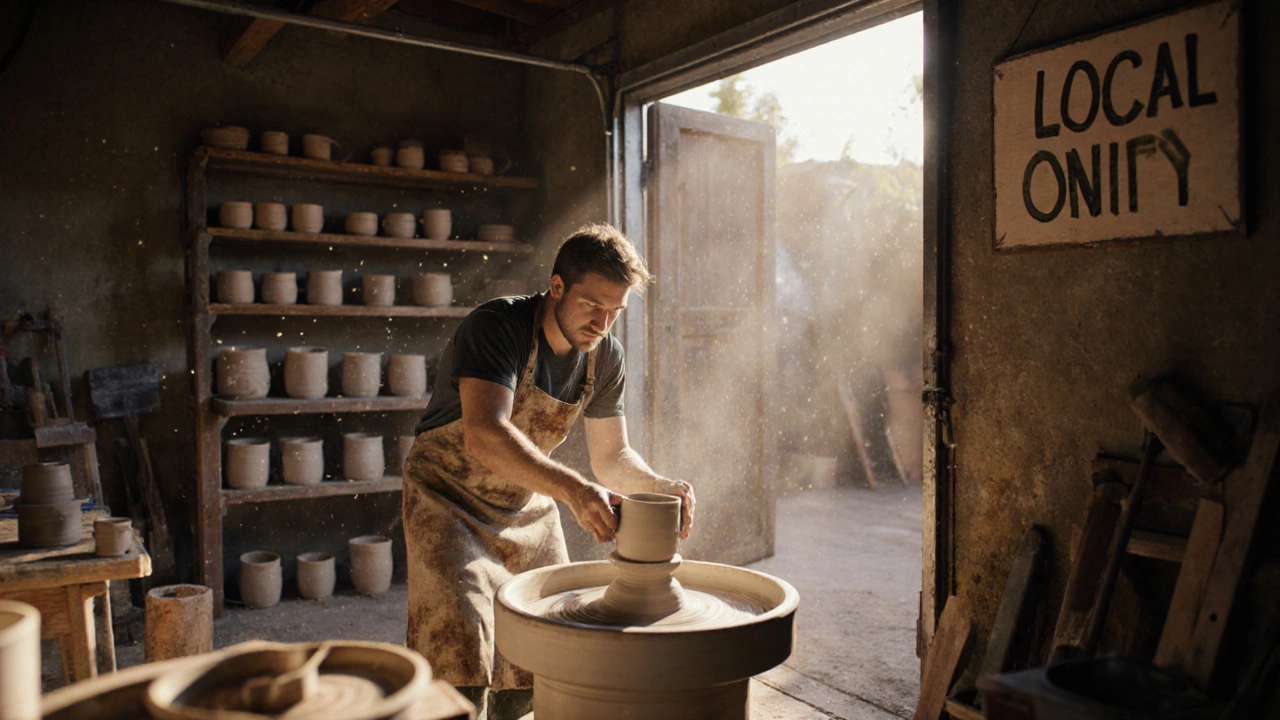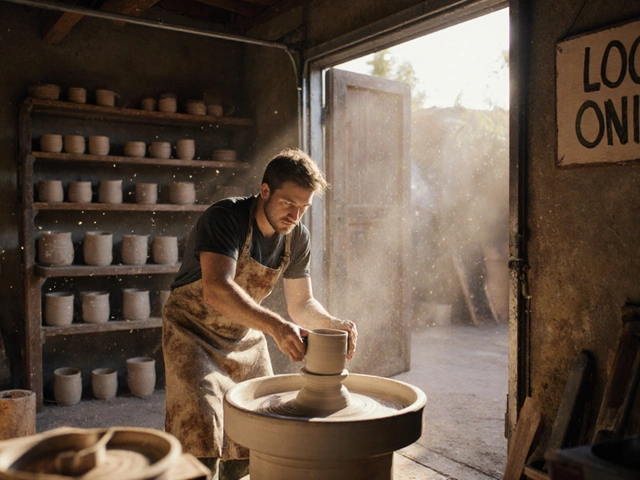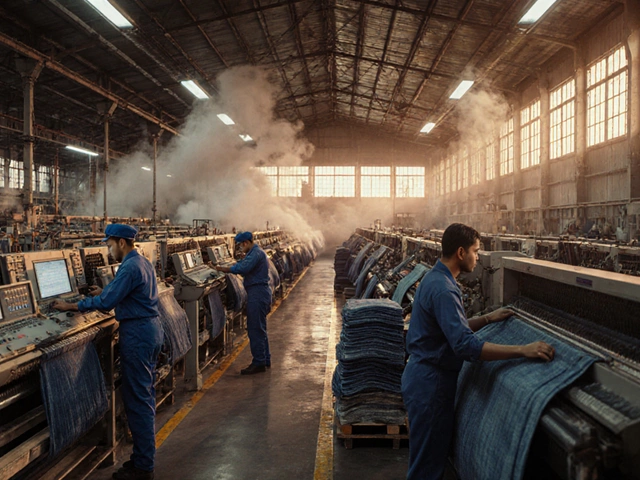Small Manufacturing Profit Calculator
Estimate Your Earnings
Estimated Annual Earnings
Based on your inputs, this represents potential earnings for a small-scale operation. The article mentions small makers typically earn £30,000–£80,000 annually working 30-40 hours per week.
Small scale manufacturing isn’t some fancy term used by economists. It’s what happens when someone makes something real - right in their garage, backyard, or tiny workshop - and sells it to people nearby. Think of a baker who makes sourdough loaves every morning and sells them at the farmers’ market. Or a guy who welds custom metal planters and ships them across the county. That’s small scale manufacturing. No giant factories. No assembly lines. Just people making stuff, one piece at a time.
What Exactly Counts as Small Scale Manufacturing?
There’s no single global rule, but in the UK, small scale manufacturing usually means businesses with fewer than 50 employees and annual turnover under £10 million. In India, it’s often defined as operations with investment in plant and machinery under ₹10 crore. In the US, the SBA says under 500 employees. The real difference isn’t in the numbers - it’s in the scale.
Large manufacturers buy steel in trainloads. Small scale makers buy it by the sheet. Big factories run 24/7 with robotic arms. Small shops open at 7 a.m., close at 6 p.m., and the owner’s hands are still greasy when they lock up. They don’t outsource packaging - they tape the boxes themselves.
It’s not about being ‘small’ because you can’t grow. It’s about being small because you choose to. Many small manufacturers stick to this size on purpose. They want control. They want to know every customer’s name. They want to fix a broken hinge without waiting for a corporate approval email.
How Is It Different From Big Factory Manufacturing?
Let’s say you need 10,000 ceramic mugs. A big factory will use a mold, fire them in a kiln that runs for days, and ship them in pallets. A small manufacturer? They might hand-throw 20 a day. Each one has slight variations - a wobble in the rim, a brushstroke that’s a little off. That’s not a defect. That’s character.
Big manufacturers optimize for speed and cost per unit. Small manufacturers optimize for quality, customization, and connection. One makes the same thing over and over. The other makes something different every time - maybe a mug with your dog’s name on it, or a set of spoons shaped like leaves from your garden.
Big factories need huge upfront investment: automated lines, warehouses, logistics teams. Small makers start with a lathe, a soldering iron, or a sewing machine bought secondhand off Facebook Marketplace. Their overhead is low. Their risk is lower. Their ability to pivot? Much higher.
Common Types of Small Scale Manufacturing
You’d be surprised how many everyday things are made this way:
- Food processing: Small-batch jams, pickled vegetables, organic honey, or artisanal cheese made in a kitchen that also doubles as a home.
- Textile manufacturing: Handwoven scarves, custom embroidery on denim jackets, or upcycled quilts from old clothes.
- Plastic manufacturing: 3D-printed phone cases, custom garden markers, or replacement parts for old appliances.
- Electronics manufacturing: Hand-soldered LED lighting kits, custom guitar pedals, or repair kits for smart home devices.
- Furniture manufacturing: Solid wood bookshelves built from reclaimed timber, or kids’ tables painted by hand.
- Machinery manufacturing: Custom garden tools, small CNC routers for hobbyists, or repair parts for vintage farm equipment.
These aren’t side hustles. These are real businesses. In the UK alone, over 250,000 small manufacturers employ more than 1.3 million people. That’s more than the entire UK railway network.

Why Small Scale Manufacturing Matters
It’s not just about making things. It’s about keeping places alive.
When a big factory closes in a town, the whole community feels it. The pub loses its lunchtime crowd. The hardware store stops selling bolts and nails. The bus route gets cut. Small scale manufacturing doesn’t leave. It stays. It grows slowly. It hires the local teenager who just graduated. It buys materials from the family-run hardware store down the road.
It’s also more sustainable. Less shipping. Less packaging waste. Fewer carbon miles. A small potter in Wales doesn’t ship clay from China - they dig it from a field 20 miles away. Their glazes are mixed from natural minerals, not imported synthetics.
And when something breaks? You don’t throw it away. You take it back to the maker. They fix it. That’s the kind of relationship you don’t get from Amazon.
How to Start Small Scale Manufacturing
You don’t need a degree. You don’t need a loan. You need three things: a skill, a tool, and a customer.
- Start with what you already make: Do you sew? Bake? Carve wood? Repair bikes? That’s your product. Don’t wait for the perfect idea. Start with what you’re already doing.
- Use what you have: Your kitchen table can be a workbench. Your old sewing machine can make bags. A $100 3D printer can turn plastic filament into phone stands.
- Sell locally first: Farmers’ markets, craft fairs, Instagram, or even just handing samples to neighbors. Get feedback before you invest in branding or packaging.
- Keep costs low: Don’t buy a $10,000 CNC machine on day one. Use a local makerspace. Rent time on shared equipment. Learn as you go.
- Document your process: People love to know how things are made. Film yourself shaping clay, cutting fabric, or welding metal. Share it. That’s your marketing.
One woman in Liverpool started making herbal soaps in her kitchen after her son had sensitive skin. Two years later, she supplies 12 local shops and ships across the UK. She still makes each bar by hand. She still writes a thank-you note in every package.

The Hidden Challenges
It’s not all handmade charm and cozy workshops. There are real hurdles:
- Time: You’re the maker, the packer, the bookkeeper, the marketer, and the delivery driver.
- Cash flow: Customers pay slowly. Suppliers demand payment upfront. You might go weeks without seeing a profit.
- Regulations: Food? You need hygiene certificates. Electronics? Safety standards. Even soap has labeling rules.
- Scaling without losing soul: If you get too big, you risk becoming what you hated - a faceless company.
Many small manufacturers quit not because they failed - but because they got overwhelmed. The key? Don’t try to do everything at once. Master one product. Serve one community. Grow slowly. Stay human.
What’s Next for Small Scale Manufacturing?
Technology is helping, not replacing, small makers.
Open-source CNC designs let you build your own router for under £300. Online platforms like Etsy, Shopify, and even TikTok make it easy to find customers without a warehouse. Local councils in the UK now offer grants for small manufacturers to upgrade tools - like £5,000 to buy a laser cutter or a commercial-grade mixer.
More people are asking: ‘Who made this?’ They care about origins. They want to know the person behind the product. That’s the real advantage small scale manufacturers have - authenticity.
The future isn’t about big factories winning. It’s about thousands of small ones thriving - side by side, in towns and cities, making things that matter.
Is small scale manufacturing profitable?
Yes - if you focus on value, not volume. Small manufacturers often charge more per unit because their products are handmade, unique, or locally sourced. A handmade ceramic mug might sell for £25, while a factory-made one sells for £5. Profit comes from margins, not sales volume. Many small makers earn £30,000-£80,000 a year working 30-40 hours a week.
Do I need a business license for small scale manufacturing?
It depends on what you’re making and where you are. In the UK, you must register as self-employed with HMRC. If you make food, you need local authority registration for food premises. Selling electronics? You may need CE marking. Always check your local regulations - but don’t let bureaucracy stop you from starting. Many councils offer free advice for new makers.
Can small scale manufacturing compete with big brands?
Not by price. But by story, quality, and connection. Big brands sell products. Small makers sell trust. People choose a handmade leather wallet from a maker in Bristol because they know the maker’s name, saw their Instagram videos, and can text them if it breaks. That loyalty can’t be bought with ads.
What tools do I need to start small scale manufacturing?
Start with what you already own. A sewing machine, a soldering iron, a hand saw, a kitchen oven - these can be your first tools. As you grow, upgrade one piece at a time. Many local makerspaces offer access to laser cutters, 3D printers, and CNC machines for a low monthly fee. You don’t need to own everything - just know how to use what’s available.
Are there government grants for small manufacturers?
Yes. In the UK, programs like the Made in Britain grant, Local Growth Fund, and the UK Shared Prosperity Fund offer support for small manufacturers to buy equipment, train staff, or access export markets. Check your local council’s economic development page - many offer £1,000-£10,000 grants for small workshops. Don’t assume you’re too small - you’re exactly who these programs are for.





